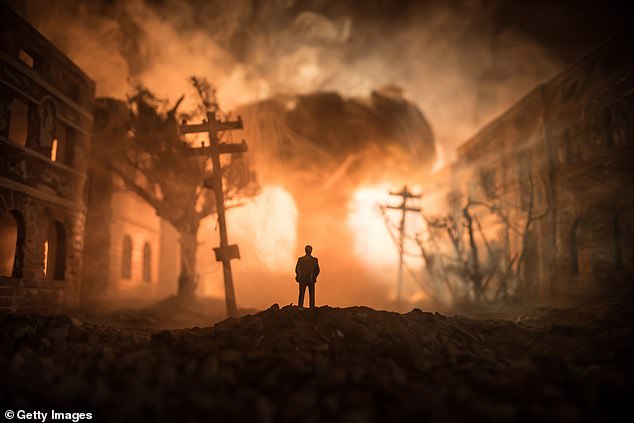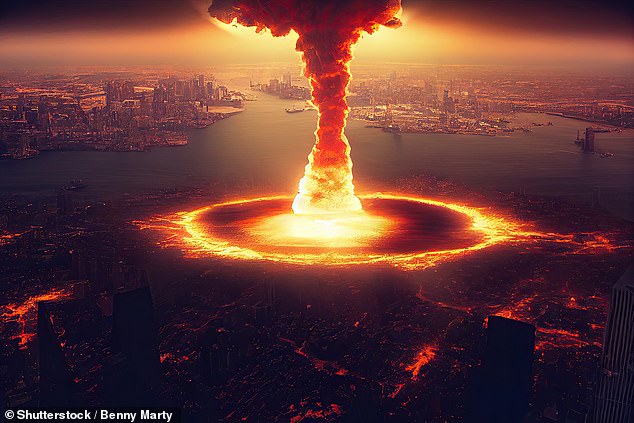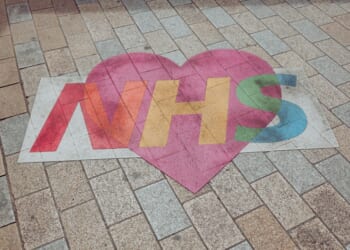A week after the first bomb dropped, sparking an all-out nuclear war, the ruins of cities worldwide are still smouldering. In the areas hit directly by the 4,000 explosions in the targeted countries, there is nothing left: the firestorms produced intense heat and virtually all flammable material was consumed.
Some 770 million people have been killed and skeletons are everywhere, alongside the haunting shadows left by people who were caught outside during the first blasts and vaporised. Given what is about to unfold, they were the lucky ones.
The survivors from cities, where they are able, have begun to move. Everyone, no matter their former status or profession, is now a refugee.
Roads are strewn with debris, so no one drives a car.
Those with half-incinerated clothes and hair, many with horrific burns over their legs, faces and torsos, shuffle along, clinging to parents and partners, but they will not last long.
Apart from makeshift bandages made out of torn-up clothes, there is no medical aid of any sort, and the walking wounded will soon succumb to radiation sickness, blood loss or septicaemia.
Although many have never encountered a dead body before, now they have seen hundreds and they are numbed to the horror: people with shattered limbs, burned-off faces, bodies twisted and disfigured where they fell.

Human civilisation is finished, and those who have survived the initial holocaust are about to experience what nuclear winter means
There is no effort to gather or bury cadavers – there are too many, and, after all, there is no point. These dead people were all once someone’s son or daughter, mother or father, uncle or aunt, colleague or girlfriend, but that no longer matters. Now they are just the nameless and numberless dead, and soon there will be no one left to even mourn the mourners.
Human civilisation is finished, and those who have survived the initial holocaust are about to experience what nuclear winter means.
Terrifying though it is, the scenario outlined above should be no surprise. That a full-scale nuclear war could precipitate a planet-wide deep freeze has been understood since the early 1980s.
Today scientists have a much greater understanding of the impacts, thanks to the same climate models widely used to project the planet’s future under global-warming scenarios.
Their findings are almost indescribably horrific, but very few have any idea what a nuclear war would realistically mean and kick the can down the road, saying ‘maybe it will happen but there’s nothing I can do about it’.
As I wrote yesterday, I believe we must confront these realities head-on if we are to replace this fatalism with an activism which can help to reduce the threat. So let’s return to our world a week on from the attacks.
Already the disc of the sun is visible at midday through a brown haze, as if on a foggy day or a solar eclipse, and it grows dimmer as time passes. Up in the stratosphere, the sun is heating the tops of the smoke clouds that were produced by the burning cities, and billions of tons of particles of soot are moving to circulate worldwide in both hemispheres.
In America, Europe and Asia, temperatures have begun to fall, even though it is still midsummer. Overnight, ice has appeared on the dirty puddles that line the empty roads as the refugees shuffle past, and people have begun to pile more coats and blankets on themselves that they strip – now with no ceremony and little thought – from corpses.
The chill lasts all day, and frost becomes a nightly occurrence.
Despite the horror, some are making an effort at community.
Protection squads are brought together to defend shops and supermarkets from looters, with makeshift weapons distributed to aid in the effort. Few people have guns, and ammunition will not last long, but spiked clubs are effective deterrents – for now. Would-be looters stay in the shadows and bide their time.
Organised national government ceased with the war.
Electronic communications were knocked out and there is no broadcast media or internet.
The electricity grid went down too – at night the darkness is total, with only the fires set by refugees providing any light.
The real military has vanished: most army and air force installations were directly targeted in nuclear strikes and there is no command and control system left to issue orders to soldiers or other military personnel who survived.
Arms stores are emptied, with small arms and ammunition in particular demand. Thereafter, men in uniform occasionally appear among the refugees – they carry guns openly and people glance nervously in their direction.
But some seek them out for protection, and soon groups appear, headed by those with loaded weapons. Those who openly challenge these armed gangs are hanged to save ammunition, their emaciated bodies swing gruesomely from trees and lamp posts.
Glimpsed through the gathering gloom, these macabre shapes send a useful signal to the dwindling refugee army about who is now in control.
After two months, the darkness is almost total. Even in the middle of the day only the barest outlines can be distinguished in the blackness.
With no electricity, the only light is from flaming torches carried by those in marauding gangs as they roam in search of food and other supplies. For a while they form territories with defined borders patrolled by members.
Those refugees who still have no affiliation hide as best they can in ditches and behind the embankments of empty motorways, while householders in remote, forested areas who have survived so far on their own cans and preserved foods wait in terror for the assault they know must come. They dare not provide any illumination, lest they attract unwelcome attention, so families sit in the cold.
There is no news, and people have little contact with each other, but it is clear what is happening to keep the gangs alive: out in the freezing darkness, unspeakable things are taking place.
Sheep and cattle, cats and dogs, all have already been consumed, and the only fresh meat still widely available is human. The smell of roasting flesh, an increasingly familiar aroma faintly reminiscent of pork, hangs in the valleys, along roadsides and around houses requisitioned by gangs.
There is plenty of firewood: every tree is dead or dying, and abandoned buildings can be hacked down for dry wood or occupied for temporary shelter.
There is no God and no law, but people in the gangs swear loyalty oaths and perform ceremonies around large fires lit specially in the gloom, banging ominous rhythms on makeshift drums.
People cower for miles as they hear these noises echoing through the endless night.
No one can even remember why the war was fought and which side they were supposedly on. The old affiliations of nations and states, regions, tribes and families are increasingly meaningless, but new ones have appeared.
The gangs have names, totems and brands, and these strike fear – as they are intended to do. They travel long distances through the emptying land, as stored food in any single area is quickly used up.
Some people know how to dig up roots and collect bark that is scraped from dying trees. These are boiled, together with old crop residues looted from farms.

Viewed from space, it looks as if Earth has been switched off, as suddenly as a light bulb. A planet that once radiated light on its night side from a thousand vibrant cities has plunged into a darkness as deep as the grave
Protein-rich animal feeds, stored in plastic sacks in barns, are particularly valuable – augmented with human flesh, they provide a gruel-like daily hot meal that lasts for weeks.
Small wars break out over these treasure troves, as gangs engage in gunfights. These do not last long, and with no first aid and raging diseases,a single bullet wound is a death sentence, and the wounded know they will end up in the pot.
Most prized of all in some parts of the hinterland, particularly in what used to be America, are the preppers. These are mostly single, armed men who have stockpiled vast amounts of food in expectation of just these sorts of times, but they soon run out of ammunition once they have been found and engaged in shootouts.
Winkled out of their bunkers and hiding places like fat grubs, their bodies are dismembered with particular care and ceremony, while their camo-gear clothing is given out according to rank.
The treasure trove stores of prepper food are distributed to the victors: rare treats such as tinned fruit, beans, preserved non-human meat and other dried goods.
Three months have now passed and the temperature is below freezing virtually the entire time. There is no distinction between day and night and no fresh water to be had.
There is some discoloured snow, which falls like ash from invisible skies, but little wind disturbs the stillness of this new ice age.
Even in temperate countries it is now as cold as Siberia. Winter’s grip is becoming stronger all the time. A polar night has descended on the world.
Viewed from space, it looks as if Earth has been switched off, as suddenly as a light bulb. A planet that once radiated light on its night side from a thousand vibrant cities has plunged into a darkness as deep as the grave.
I have only written so far about humans but, of course, all life on our planet is affected. With no light penetrating the soot cloud that shadows most of its surface, food webs have collapsed.
Tropical forests have died or desiccated, unleashing conflagrations as the lack of rainfall turns leaves brown and parches peaty soils. These new sources of smoke augment the brown cloud that hangs ever-present in the stratosphere.
Phytoplankton in the seas die and sink to the ocean floor, causing a mass die-off as fish and other species quickly succumb to the lack of food.
On land, frosts devastate plants in the tropics, where some sunlight still penetrates and occasional dirty rain still falls, but starving humans or herbivores quickly strip away anything that is green.
The only life that survives is that which can lay dormant for long periods: seeds, or roots, or plants that are adapted to long winters and able to sit out the brown cloud in stillness and silence, or small animals or insects that can hibernate or survive underground.
Nothing lasts for ever, the deep freeze included, and a decade after the war the sun is finally breaking through the planet-wide soot cloud. But now a new killer is appearing.
The nuclear blasts and soot-driven heating of the stratosphere have driven chemical reactions that are destroying the ozone layer, with losses of 75 per cent or more in the higher latitudes.
Thus nuclear winter gives way to a ‘UV spring’, as scientists have termed it.
With ultraviolet (UV) levels soaring, the exposed skin of any human survivors is burned within minutes, and a wave of skin cancers joins the pulse of carcinogenesis driven by the radioactive isotopes that now pollute every scrap of land and waterway.
As long-dormant seeds sprout with the springtime temperatures and sunlight, fragile young leaves are scorched and burned by the intense UV. The penetrating radiation – both solar and bomb-related – leaves whole landscapes virtually sterile under the harsh glare of the returning sun.
As solar heating increases across the land and oceans, it restarts the long-dormant atmospheric circulation, which in turn begins to generate clouds and renewed rainfall.
Monsoons – long absent during the freeze – produce sudden floods, which wash torrents of mud off denuded hillsides and through skeletal cities, whose exposed steel fabric now starts to rust.
Some humans may have hung on through this apocalypse, perhaps even retaining vestiges of civilisation. Australia and New Zealand have been proposed as sanctuaries, as have some tropical islands with favourable geographical locations, cultivation potential and relatively small populations.
But supply lines have been cut since the beginning of the war, global communications have ceased and trade is now a distant memory. There is no petrol to run vehicles, no imported foodstuffs or spare parts and no fertilisers arriving by ship to grow crops.
Solar power might still generate electricity in a few areas, but with no grids and not much left to use electricity for, this will be largely a return to primitive times for any survivors. They will not be in a position to simply ‘reboot’ industrial civilisation – the modern era has vanished, for ever.







